Banded Geckos in California - Genus Coleonyx

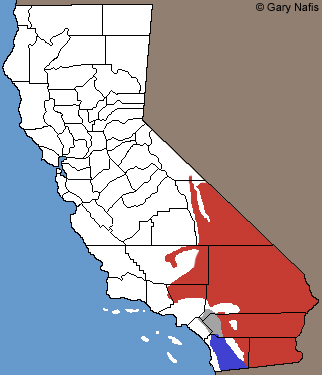
Dark Blue: San Diego Banded Gecko
Red: Desert Banded Gecko
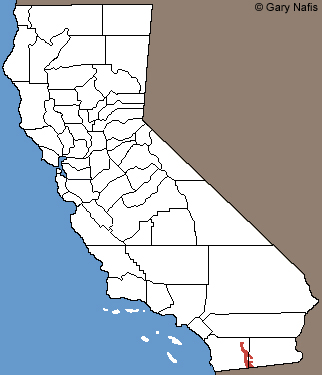
Red: Peninsular Banded Gecko

| Banded Geckos are small, plump, nocturnal lizards with thin, soft skin, and movable eyelids with vertical pupils. Color is pale yellow or pink with dark bands and spots. These geckos remain mostly on the ground instead of climbing high up on walls like many species of geckos. They are often found on desert roads on hot nights or hiding under debris in the daytime. Two species are found in California: 1. Coleonyx switaki - Switak's Banded Gecko One subspecies is found in California: Coleonyx switaki switiki - Peninsular Banded Gecko (Sometimes called Barefoot Gecko or Barefoot Banded Gecko) 2. Coleonyx variegatus - Western Banded Gecko Two subspecies of Western Banded Gecko are found in California: 1. Coleonyx variegatus abbotti - San Diego Banded Gecko 2. Coleonyx variegatus variegatus - Desert Banded Gecko Geographic range will help identify most Banded Geckos except where the ranges of C. v. variegatus and C. s. switaki overlap in a small area in San Diego and Imperial Counties and where C. v. abbotti and C. v. variegatus come into contact in eastern San Bernardino and Riverside Counties. |
||
| [Four more subspecies of Coleonyx variegatus are found outside of California: (Map of Subspecies) Coleonyx variegatus bogerti - Tucson Banded Gecko Coleonyx variegatus peninsularis - San Lucan Banded Gecko Coleonyx variegatus sonoriensis - Sonoran Banded Gecko Coleonyx variegatus utahensis - Utah Banded Gecko] |
||
Western Banded Geckos - Coleonyx variegatus |
||
| These characteristics apply to both California subspecies of C. variegatus: 2 - 3 inches long from snout to vent (5.1 - 7.6 cm). The dorsum is covered with uniform granular scales. There are more than three brown body bands between limb insertions, or the dorsum is spotted. When present, the dark transverse body bars in the adults are equal to, or narrower than, the light interspaces. The digits are delicate. Preanal pores in the males usually number 7 or less. |
||
 |
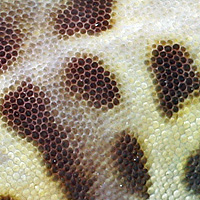 |
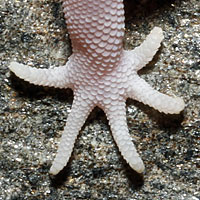 |
| The width of the dark body bars is equal to, or narrower than, the light spaces. | Scales are uniform and granular | Fingers are delicate |
Difference Between Males and Females |
||
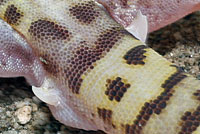 |
 |
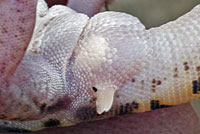 |
| Males have spurs at the base of the tail. Females do not. Compare |
||
Desert Banded Gecko - Coleonyx variegatus variegatus |
||
| This subspecies is found in the Mojave and Colorado deserts up into the Owens Valley and into part of the Central Valley. These characteristics are present on C. v. variegatus but are absent on C. v. abbotti: The dark body bands in adults tend to have lighter centers, producing a double barred effect. In some cases bars are not present, they are replaced by spotting. The top of head is spotted. The nuchal light loop passing around the back of the head is irregular or not present. |
||
 |
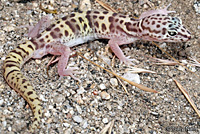 |
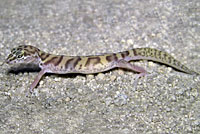 |
| Dark bands often have a light center | ||
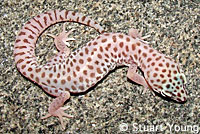 |
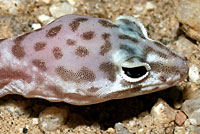 |
|
| Some adults have no bands, only spots. © Stuart Young |
Adults have large dark markings on the head (but juvenile heads are plain or lightly spotted.) The nuchal loop extending around the head from the eyes is irregular or not present. |
|
San Diego Banded Gecko - Coleonyx variegatus abbotti |
||
| Found west of the peninsular mountains in southern California. These characteristics are present on C. v. abbotti but are absent on C. v. variegatus: The dark body bands in adults are a solid color. The top of the head is also a solid color, not heavily spotted. A light-colored clearly-defined nuchal loop extends from the eyes around the back of the head. |
||
 |
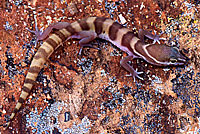 |
 |
| Bands are one color | © Stuart Young | |
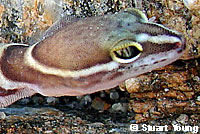 |
||
| The head does not have large dark markings. A light-colored clearly-defined nuchal loop extends from the eyes around the back of the head. © Stuart Young |
||
Comparison of C. v. abboti and C. v. varigatus |
||
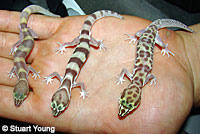 |
 |
|
| San Diego Banded Gecko (C. v. abbotti) (on fingers) Intergrade (in the middle) Desert Banded Gecko (C. v. variegatus) (near wrist) All three were found in Baja California Norte where the ranges of the two subspecies meet. © Stuart Young |
||
| The largest native Gecko species in California, measuring from 2 - 3.5 Inches long (5.1 - 8.6 cm) from snout to vent. (This is up to 1/2 inch (12.7 mm) longer than C. variegatus. Color pattern is variable, depending on habitat - from light gray, beige, yellowish, reddish brown to dark brown. With numerous round brown spots, and sometimes pale cross-bands made up of round pale spots. In California, inhabits the arid desert slopes of the eastern side of the Peninsular Ranges from near Borrego Springs south to the Baja California border. The range of C. v. variegatus overlaps the range of C. s. switaki. |
||
 |
 |
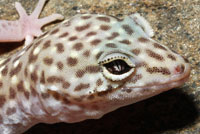 |
| Adults | ||
 |
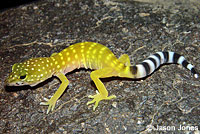 |
 |
| Adult, Imperial County, with solid bands and dorsal stripe. © Stuart Young | Hatchling, San Diego County © Jason Jones |
Juvenile, San Diego County © Kevin Law |
Comparison of C. switaki and C. variegaus |
||
| Peninsula Banded Gecko C. s. switaki |
Desert Banded Gecko C. variegatus |
|
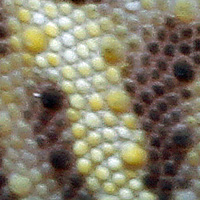 |
 |
|
| Skin is smooth with small granular scales interspersed with larger tubercles. | Skin is smooth with small granular scales that are not interspersed with larger tubercles. | |
 |
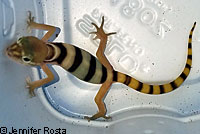 |
|
| Hatchlings are born with bright yellow or orange coloring and a distinctly black and white banded tail. The bright coloring and banding on the tail begin to fade as they reach one year of age. | Hatchlings and juveniles tend to have more well-defined unbroken bands than adults and few or no spots in-between the bands. The color can also be a brighter yellow, but they lack the black and white banded tail and the very bright orange and yellow coloring. | |
| The descriptions of Coleonyx variegatus are
mostly based on: Laurence M. Klauber. The geckos of the genus Colelonyx with description of a new subspecies. Transactions of the San Diego Society of Natural History 10(11):133-216. 1945. |
||
Return to the Top
© 2000 -
